NOTCam Calibrations
Content of this page:
Default calibrations taken in tech/service nights
On NOTCam technical and service nights, a smaller set of calibrations are always
obtained (weather permitting):
- Differential twilight flats
16 flats (8 bright and 8 faint) per filter in JHKs for WF-Cam (minimum)
16 flats (8 bright and 8 faint) per filter in ZYJHKs for WF-Cam (goal)
This is done using the script notcam.skyflat described under
NOTCam scripts.
Raw flats are always stored for download on our ftp site at
/pub/service/calib/.
Differential master flats are made available in the
NOTCam flats archive
on a best effort basis.
- NIR photometric standard star fields
One (minimum) or two (goal) NIR standard star fields at 3 airmasses in JHKs
(WF-Cam) if the sky is photometric or clear
This is done using the scripts notcam.as**-jhk described under
NOTCam scripts.
Raw standard star images are available for download on our
ftp site at /pub/service/calib/.
- In-situ spectral lamps for each spectroscopy target and wavelength region
Wavelength calibration lamps (Argon and/or Xenon) are taken on target, for the
wavelength regions used, due to instrument flexure.
3 spectral flats (Halogen lamp) are taken on target.
This is done using the script notcam.easy-calib described under
NOTCam scripts.
It takes 2 minutes per wavelength region + 1.5 minutes to mirror cover
closing and opening.
These calibration frames are provided together with the science
frames they are connected to in the data directory of each proposal.
- 6 darks in each of the exposure modes used during the night
If your data was obtained as "frames t N", darks will be taken in the morning
as "dframes t N", vice-versa for "exp t" and "mexp t N" the corresponding dark
mode will be used. Useful to make hot pixel masks.
This is done at the end of the night using the script notcam.notcam-calibs
described under
NOTCam scripts.
It may take hours.
Darks are stored for download on our ftp site at
/pub/service/calib/.
If your data needs anything beyond these calibrations, for instance twilight flat fields
for the HR-camera and/or other filters, or you want a specific standard field, it should be
stated in your description of the OB (comment field).
Note that
telluric standards must be selected by the PI with coordinates and finding
charts added, along with how frequently a telluric standard should be taken in the
case of very long spectra.
Darks
Click on the JPG images to see more details. The following table refers to the
SWIR3 array, the one currently used with NOTCam (installed and commissioned
13/12-2007).
Note that many aspects of the NOTCam darks are not well understood.
 |
Dark-0-s
|
Single dark of zero integration time, taken with the
command dark 0.
The vertical gradient in each of the 4 quadrants (called "bias tilt" or
"dc-gradient"), with highest amplitude in the first few readout lines is
a known effect with the Hawaii arrays referred to as "the reset anomaly".
Darks are taken regularly as part of our
Detector Quality Control. Measurements are done using both readout modes
(reset-read-read: dark t or mdark t N, and ramp-sampling:
dframe t N). Zero second darks can only be taken in reset-read-read
mode.
This zero second dark is the new one taken with the new clock-boards, i.e.
valid from January 2010 and onwards. Compare with
the old zero dark
|
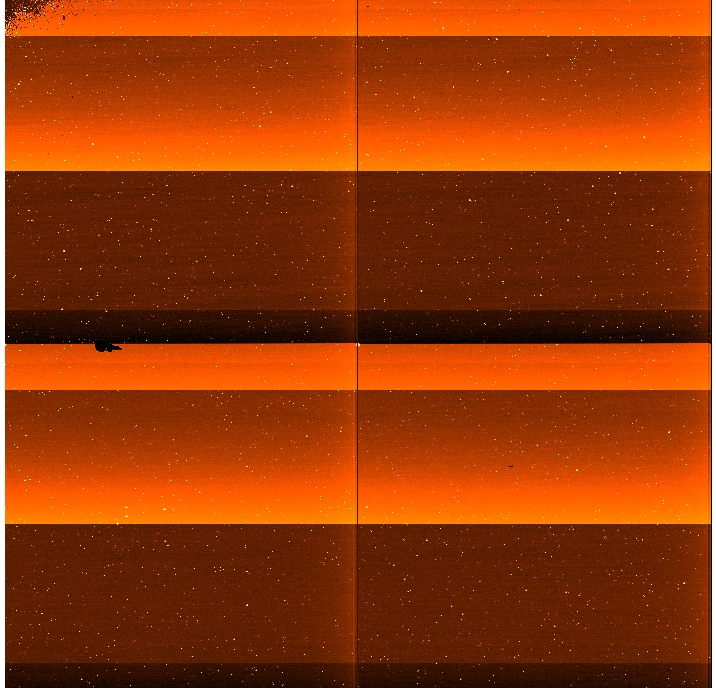 |
Dark-42-s
|
Single dark of 42s integration time, taken with the command
dark 42.
Note the increased number of hot pixels with respect to the zero second dark.
This dark is taken on Jan 17th 2010 after
the upgrade of the clock-boards and practically all the previously present
shift-register glow has now been removed.
|
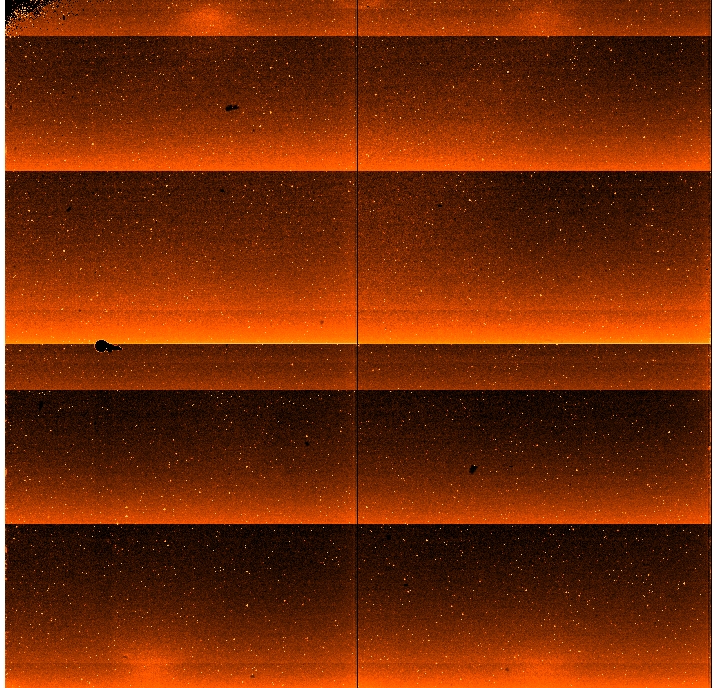 |
Dark-42-s
|
Single dark of 42s integration time, taken with the command dframe 4.2 10.
Note the increased number of hot pixels with respect to the zero second dark.
This dark is taken on Jan 17th 2010 after
the upgrade of the clock-boards and practically all the previously present
shift-register glow has now been removed.
Compare with the old 42s dark.
Note also the difference between the two 42 second darks taken with the two
readout modes reset-read-read (dark 42) and ramp-sampling (dframe 4.2 10)
where the latter is a linear regression result of the 10 non-destructive readouts,
something which strictly speaking makes sense only if the dark current is linear.
|
 |
Dark-360-s
|
Single dark of 360s integration time, taken with the command dframe 60 10.
This dark is from April 18th 2012. The structure of this dark is similar to the
42 second dark taken with the dark 42 command. These are both "long" darks
in the sense that the time between reads is longer than 30 seconds in both cases.
The zero dark and the dframe 4.2 10 dark look similar because in both cases
the time between reads is "short", i.e. shorter than 30 seconds.
|
Flat field images
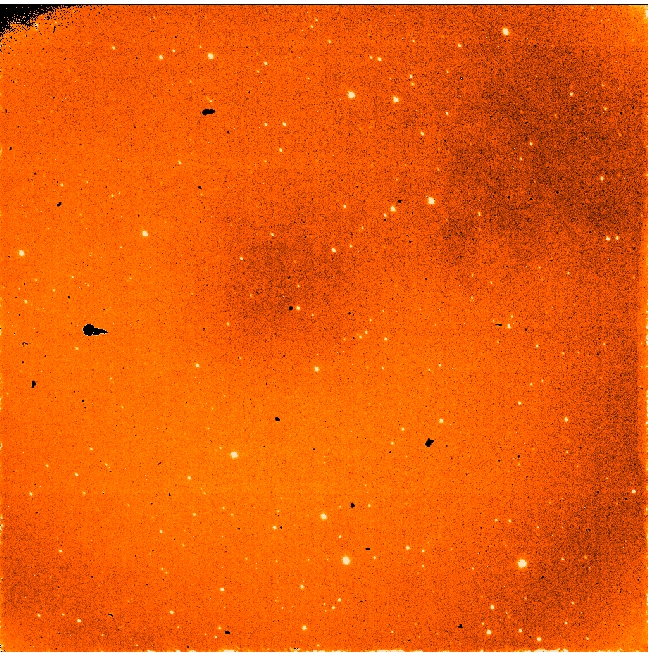 |
Flat-WF-raw |
Raw single skyflat taken in the Ks band with the WF-camera
on 08-Sep-2009.
The flat field structure for the WF camera is similar for all filters. A
number of bad pixel groups are seen. The number of stars present shows
that this particular blank field (Blank4) is not good for the near-IR.
|
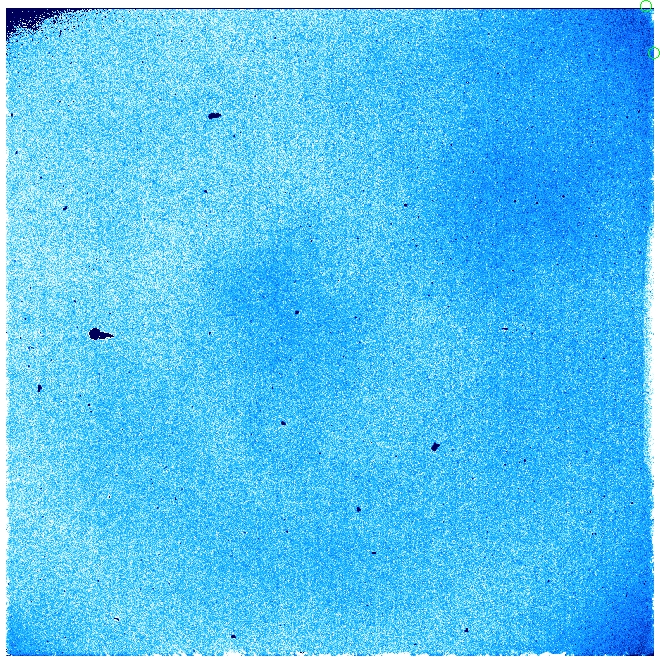 |
Flat-WF-master |
Master skyflat for the WF-camera (from 08-Sep-2009).
Composed of dithered twilight bright and faint images observed using the
sequencer script
notcam.skyflat. The differential flats produced by subtracting faint
from bright images (taken at the same pointing within a given time interval
of 25 min or less), subtract out the thermal emission, as well as the dark.
The dithering ensures that stars are filtered away. Bad pixel correction
(by interpolation) is made only for the two dead columns. No spatial
smoothing is applied to the flat.
Check the NOTCam
flatfield archive for master flats in fits format.
|
 |
Flat-HR-raw |
Raw single skyflat taken with the HR-camera on 08-Sep-2009.
The flat field pattern looks similar for all filters.
|
 |
Flat-HR-master |
Master skyflat for the HR-camera (from 08-Sep-2009).
Produced as described above for the WF camera master flats.
Check the NOTCam
flatfield archive for master flats in fits format.
|
Stability of flats
The below ratio images of master flats is an example.


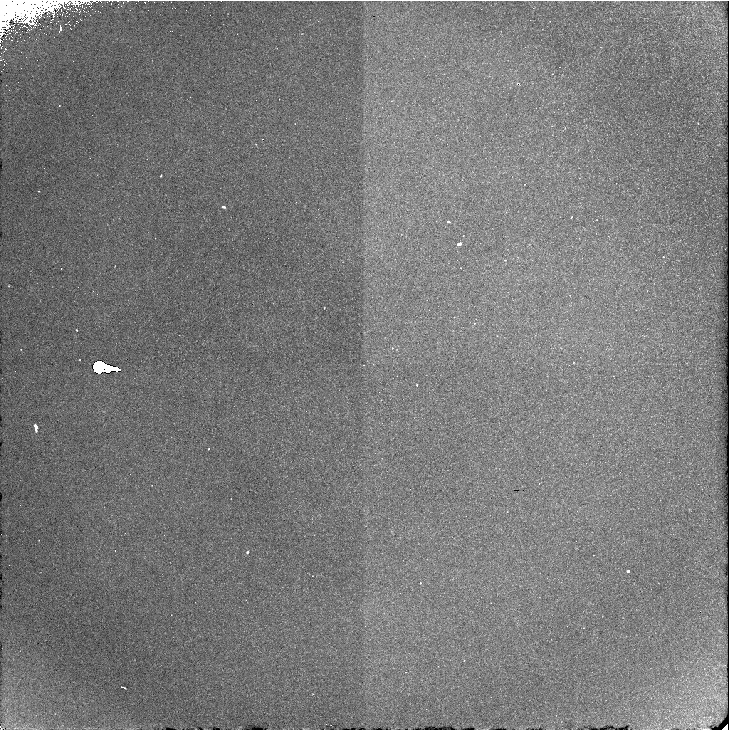
|
Ratio-WF-flats |
Ratio images of WF-cam Ks, H and J master skyflats from 7-Jan-2012 and 12-Oct-2011.
|
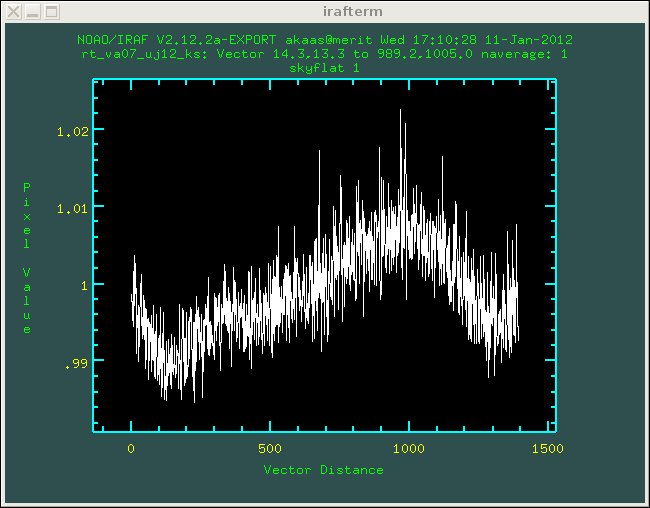
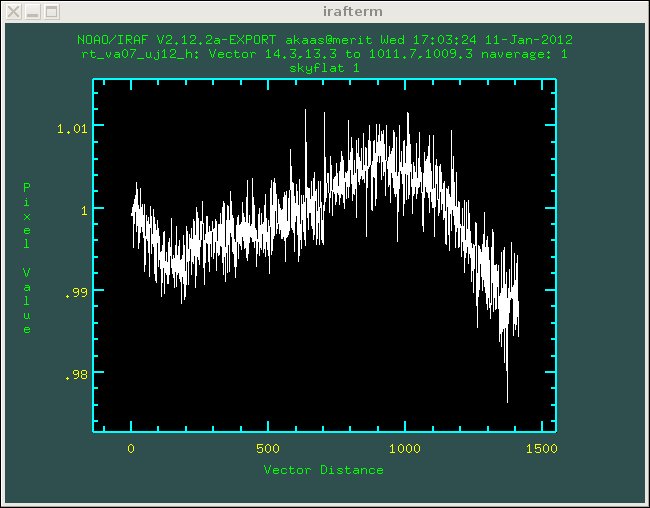
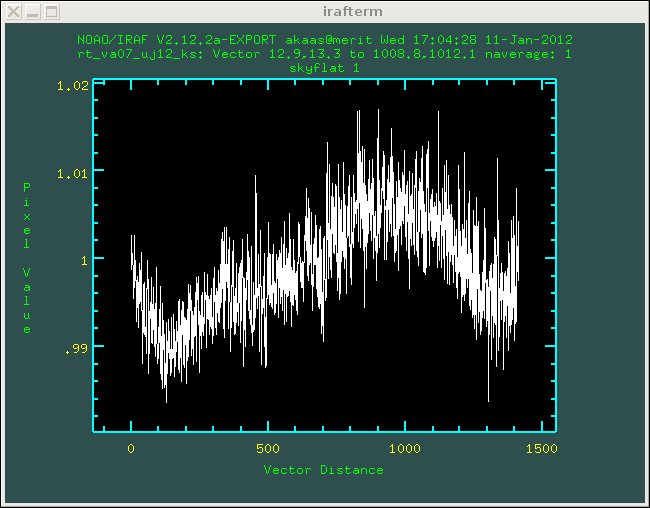
|
Ratio-WF-flats |
Diagonal cut across the ratio images of WF-cam Ks, H and J master skyflats above.
|
Bad pixel masks
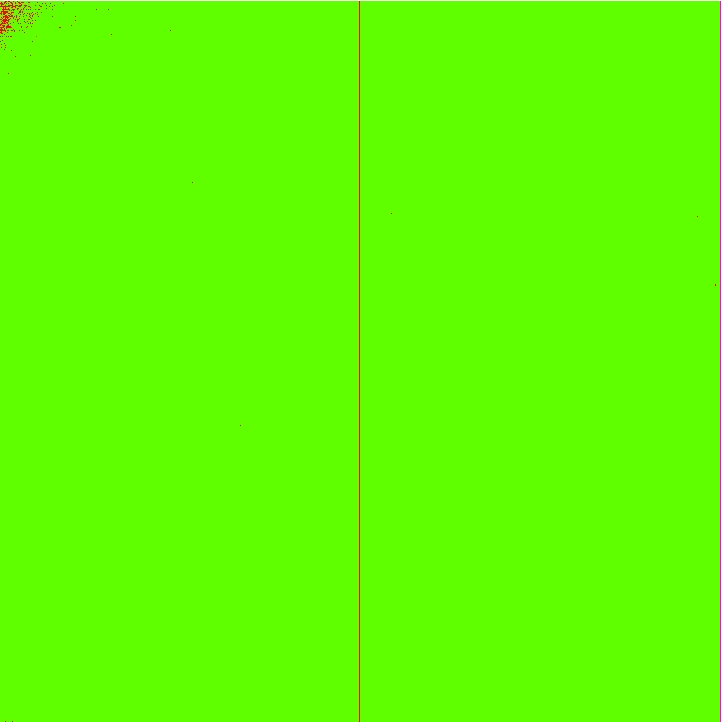 |
Badpixel-zero |
Badpixel image showing only zero-valued pixels.
These comprise mainly the two dead columns (at x=512 and x=1024; NB! a controller
problem and not physically dead pixels on the array!) and a number of individual
dead pixels, most of which are located in the upper left corner.
Masks have value 0 in general (green) and 1 for bad pixels (red).
Check the NOTCam
badpixel mask archive for badpixel masks in fits format. A typical zero-pixel image
for the SWIR3 array is called "bad_zero_sci.fits", and the fraction of zero valued
pixels over the whole array is 0.0027.
|
 |
Badpixel-cold1 |
Badpixel image showing "cold" pixels (Dec-07).
These pixels have a much lower response than normal pixels (less than 5σ) . Usually
they form small
groups.
Masks have value 0 in general (green) and 1 for bad pixels (red).
Check the NOTCam
badpixel mask archive for badpixel masks in fits format. The cold pixel mask of
SWIR3 upon installation on 13/12-2007 and until the first opening in March 2008 is
called "bad_cold1.fits". In addition to the upper left corner, there is one larger
bad-pixel feature with "cold" pixels having typically about 50% response compared to
the surrounding good pixels and comprise 0.0021 of the array.
|
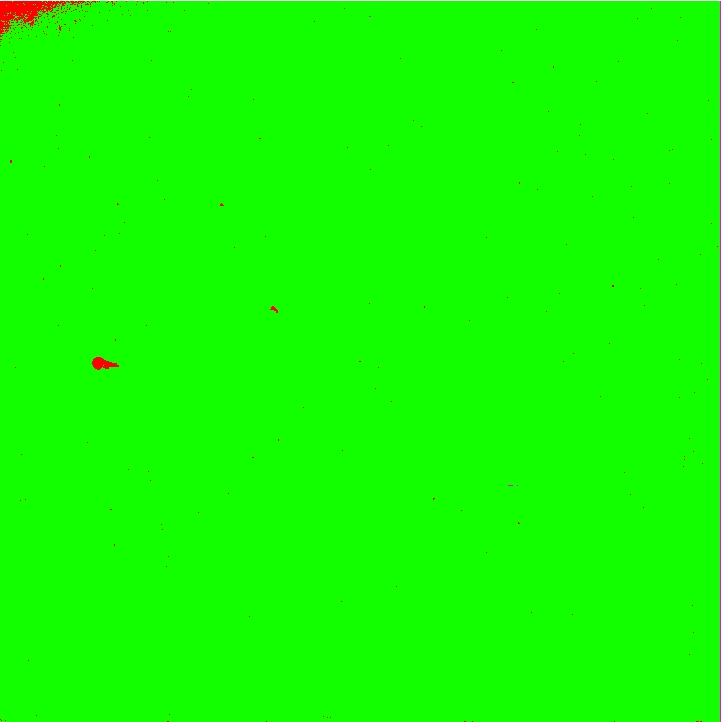 |
Badpixel-cold2 |
Badpixel image showing "cold" pixels (Jun-08).
The number of bad features in the SWIR3 array increased slightly after the opening
during March 2008. The bad pixels typically have 20-40% response compared to the
surrounding good pixels.
Masks have value 0 in general (green) and 1 for bad pixels (red).
Check the NOTCam
badpixel mask archive for badpixel masks in fits format. The mask "bad_cold2.fits"
is valid from Apr-08 to the 9th of June 2009 and comprise 0.0032 of the array.
|
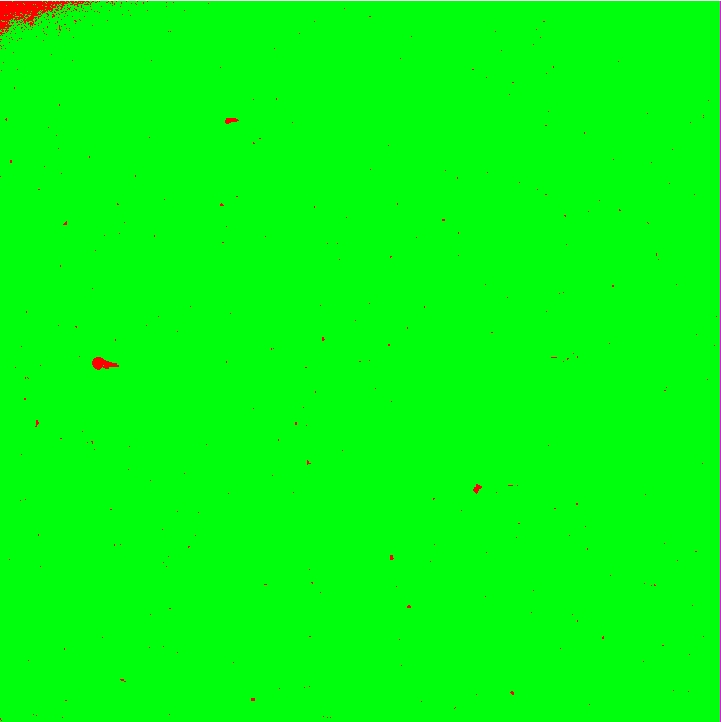 |
Badpixel-cold3 |
Badpixel image showing "cold" pixels (Sep-09).
Badpixel image showing the bad features of the SWIR3 array after the incident
on the 9/6-2009 (shaking telescope). The number of bad pixel groups increased
from one hour to the next, believed to be caused by the telescope shaking.
The bad pixels have typically 20-40% response compared to the surrounding good
pixels.
Masks have value 0 in general (green) and 1 for bad pixels (red).
Check the NOTCam
badpixel mask archive for badpixel masks in fits format. The mask "bad_cold3.fits"
is valid from the 9th of June 2009 and until 13th of Dec 2010. The cold pixels
in this mask comprise about 0.0041 of the array.
|
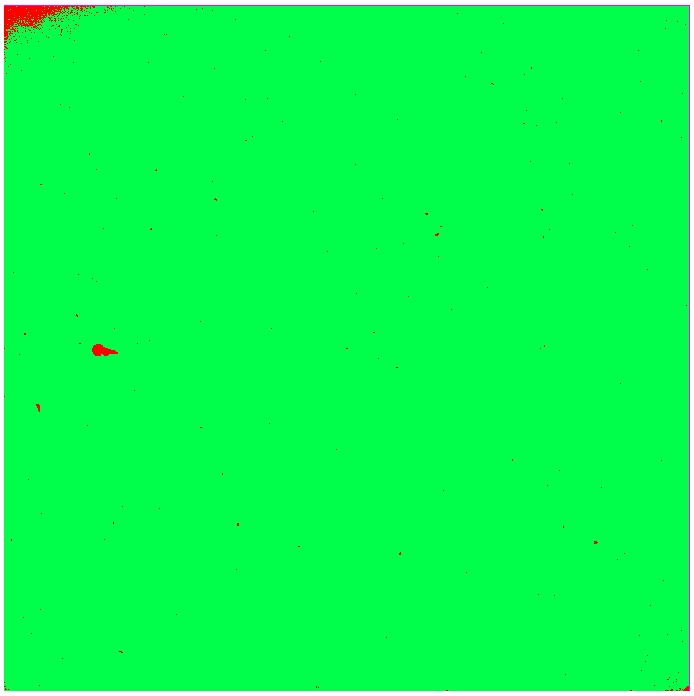 |
Badpixel-cold4 |
Badpixel image showing "cold" pixels (Feb-11).
Badpixel image showing the bad features of the SWIR3 array after the opening
of NOTCam in January 2011. The bad pixels have typically 40-80% response compared
to the surrounding good pixels.
Masks have value 0 in general (green) and 1 for bad pixels (red).
Check the NOTCam
badpixel mask archive for badpixel masks in fits format. The mask "bad_cold4.fits"
is valid from the 12th of Feb 2011 until Dec 2015. The cold pixels in this
mask comprise about 0.0037 of the array.
|
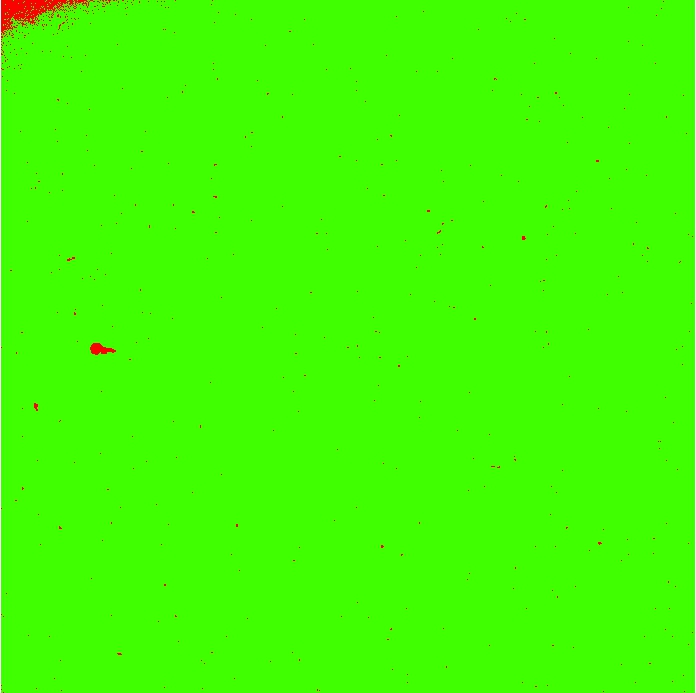 |
Badpixel-cold5 |
Badpixel image showing "cold" pixels (Jan-16).
Badpixel image showing the bad features of the SWIR3 array after the opening
of NOTCam in January 2016. The bad pixels have typically 20-80% response
compared to the surrounding good pixels.
Masks have value 0 in general (green) and 1 for bad pixels (red).
Check the NOTCam
badpixel mask archive for badpixel masks in fits format. The mask
"bad_cold5.fits" is valid from January 2016. The cold pixels in this mask comprise
about 0.0047 of the array.
|
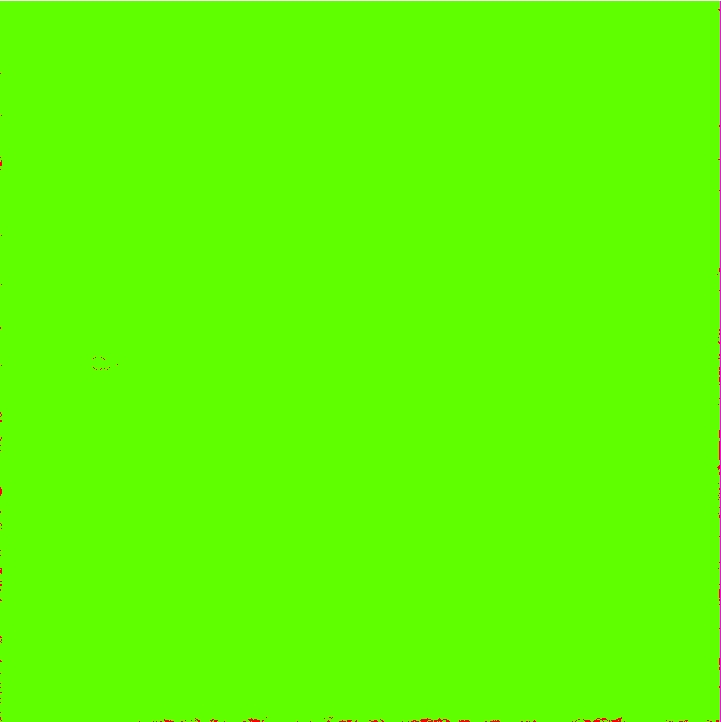 |
Badpixel-hot-05s |
Badpixel image showing "hot" pixels in short (~ 5s) exposures.
These pixels have a higher response than normal pixels. They are typically located
along the edges of the array. Note that the number of "hot" pixels depends on the
integration time, and must be properly treated.
Masks have value 0 in general (green) and 1 for bad pixels (red).
Check the NOTCam
badpixel mask archive for badpixel masks in fits format.
|
Non-linearity correction
The non-linearity of the array can be corrected pixel by pixel using the two
coefficient images "ba" and "ca". The coefficients were determined from sets
of dark-corrected lamp flats obtained using the ramp-sampling readout mode
with 10 integration times notcam.frames 4.2 10, i.e. spanning 10
intensity levels from roughly 5000 to 50000 adu. For each pixel a 3rd order
polynomial (y = ax + bx2 + cx3) was fitted to the 10
values, obtaining the three coefficients a, b, and c, which are reduced to
ba = b/a and ca = c/a.
The correction must be applied to the raw images as a first step in the
data reduction procedure.
The raw image (x) is to be corrected as follows using the correction
coefficient images ba and ca:
y = x * (1 + ba * x + ca * x**2)
The latest correction coefficient image fits files can be downloaded from the
NOTCam non-linearity
correction archive.
Here we have assumed that the array behaves linearly for low fluxes. From the
"tb06" dataset the non-linearity behaves on the average roughly as follows:
Counts Non-linear
(adu) (%)
-------------------------
5000 0.05
10000 0.23
15000 0.52
20000 0.91
25000 1.42
30000 2.04
35000 2.76
40000 3.55
45000 4.43
50000 5.37
--------------------------
Testing the non-linearity correction coefficients based on the "tb06" data
set on domeflats at later dates, such as tf19, th01, th28, and ti28, gives
rather stable results. The plots below show raw data (symbols) and corrected
data (lines) for selected areas in each quadrant: q0 or lower left (white),
q1 or lower right (red), q2 or upper right (green), and q3 or upper left
(blue). The y-axis shows the count level per second and the x-axis shows the
exposure time. The non-linearity correction seems to work well up to levels
of at least 46000 ADUs in the raw data.
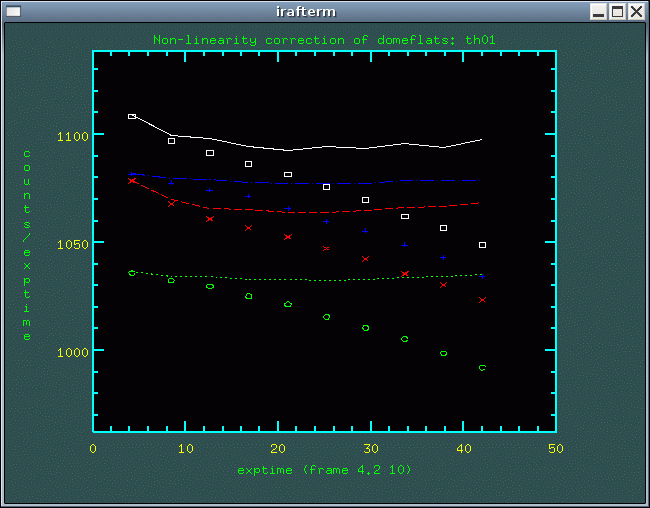 
Distortion correction WF-cam
The WF-camera of NOTCam suffers from optical distortion. An early model was
developed by M. Gålfalk in 2005 (see the NOTCam User's Guide - Reductions).
New models for the distortion in the J, H, and Ks bands were found from sharp
(fwhm ~ 0.5'') images of a stellar rich field in Baade's Window in June 2009.
About 300 2MASS stars with positions accurate to 0.08'' over the Ks magnitude
range from 9 to 14 are present in the selected field.
A total of 260 stars (avoiding multiples unresolved by 2MASS), each at 9
positions on the array, gave a grid of 2340 XY positions with reference
coordinates per filter. The IRAF task GEOMAP was used with a 4th order
Legendre surface polynomial to produce a spatial transformation for each
filter. The result is stored in the IRAF database "notcam.db" which can be
downloaded from the NOTCam distortion correction archive.
Blinking an uncorrected with a distortion corrected image.

In version 2.4 of the IRAF quick-look reduction package notcam.cl
(download
and installation info) the tasks reduce and reduce_bs
include optional distortion correction. If selected, the correction is
applied after flat-fielding, bad-pixel correction and sky subtraction on the
individual images using the IRAF task GEOTRAN. Note that the WCS info in the
header is not updated and is not in agreement with the distortion correction.
Support does not yet exist in the IRAF WCS interface for the higher order
distortion corrections that GEOTRAN is capable of performing on the image.
The model is valid for the SWIR3 array and the internal focus value set
to 5650, which is the default for imaging with the WF-camera. (Note that for
other internal foci the correction will not work.) The correction may work
better for some data than other, but no clear dependence has been found with
rotator position or altitude. One corner in particular is hard to correct.
H-band image of the field used to make the model. To the left uncorrected,
and to the right corrected.
Result of 9 dithered images combined.

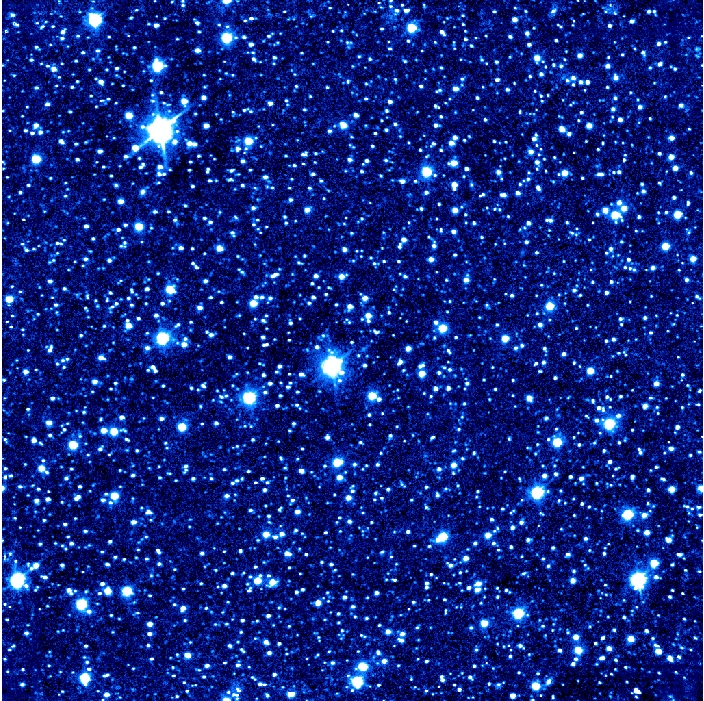
Illumination correction for the WF camera
The photometric response over the field of view may not be flat even after
having divided by the nightly flat field. For many IR arrays a so-called
photometric surface correction, or illumination correction, is needed. It
is believed to originate in scattered light, possibly from the twilight
flats.
For the WF-camera H-band Janz, Laurikainen, Lisker et al. obtained calibration
data during photometric nights in March 2012 and present a model for the surface
correction for this filter in their paper
Janz et al. 2014, ApJ 786, 105.
It is based on measuring one standard star repeatedly scanning it over 25
positions on the array 15 times.
It is unclear how stable this is with time, but the corrections agree with the
trends seen in previous analyses of clusters. Similar modelling for the J and
Ks bands with the WF-camera is currently on-going.
The fits file is obtained here:
FITS image.
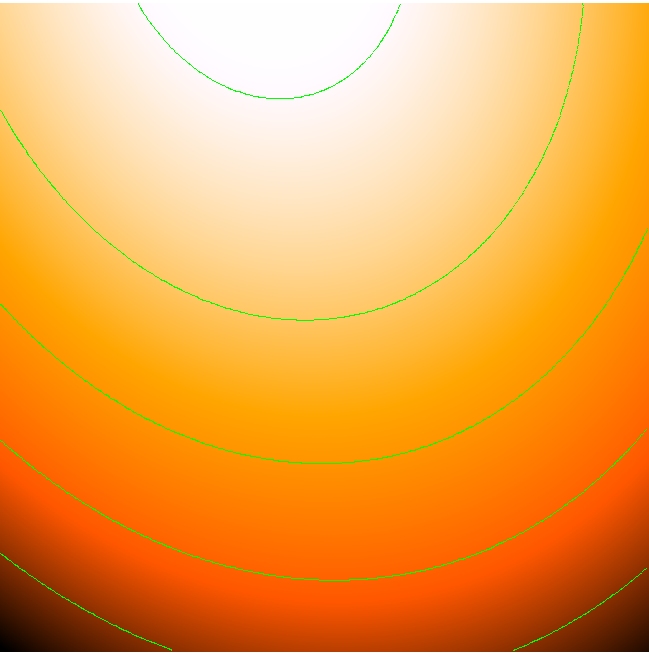
Photometric surface obtained for WF camera and H-band during March 2012 by
Janz et al. 2013.
The contours go from 1.05 at the top through 1.02, 0.99,
0.96 to 0.94 at the bottom corners.
|



























